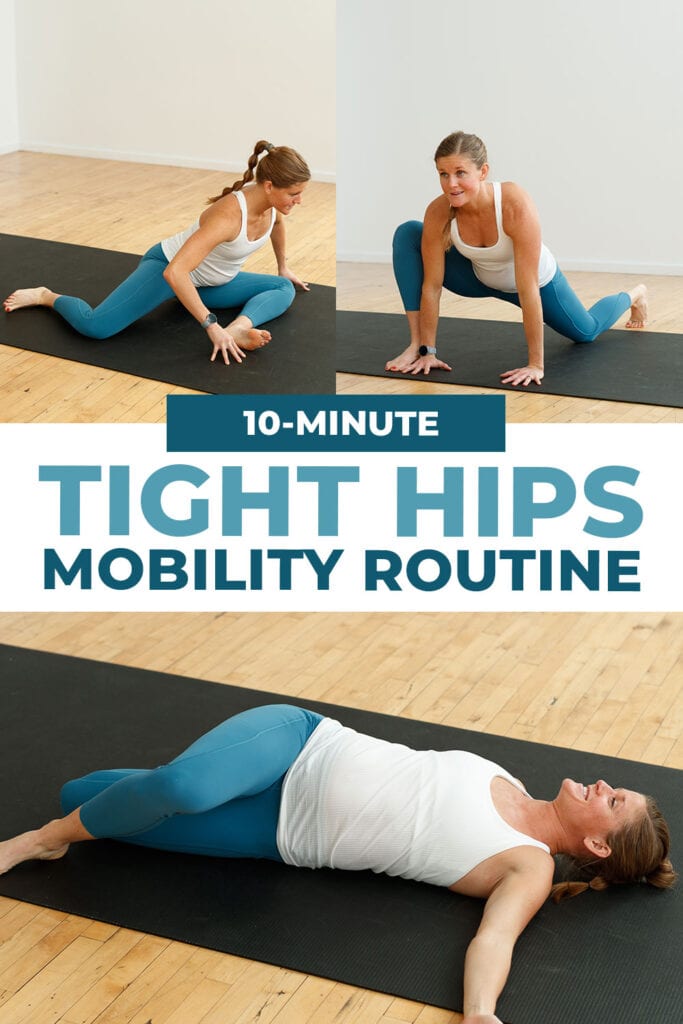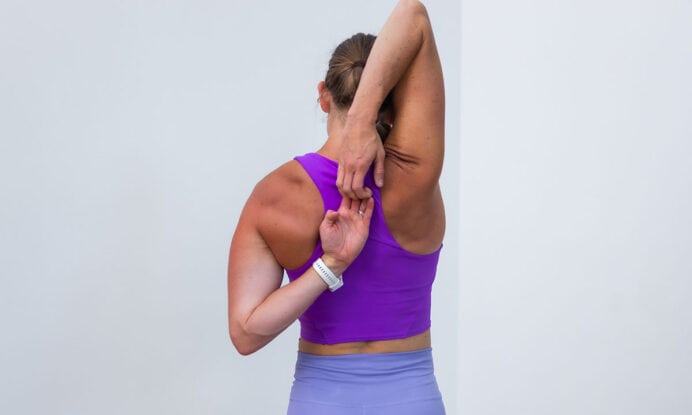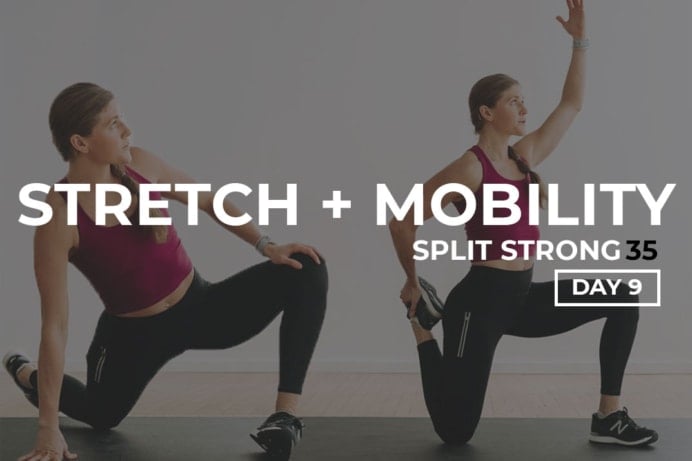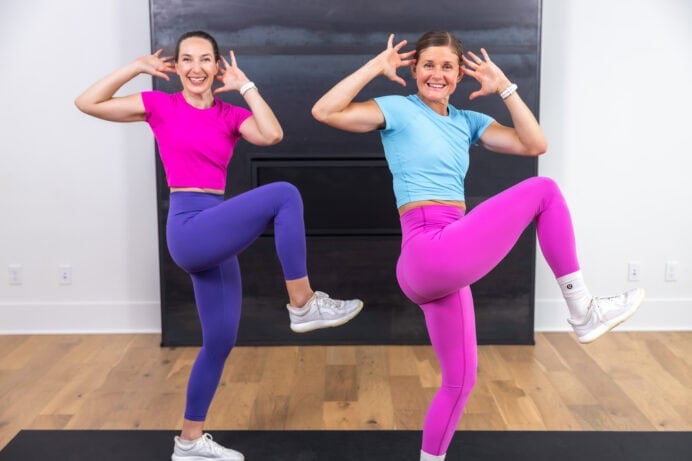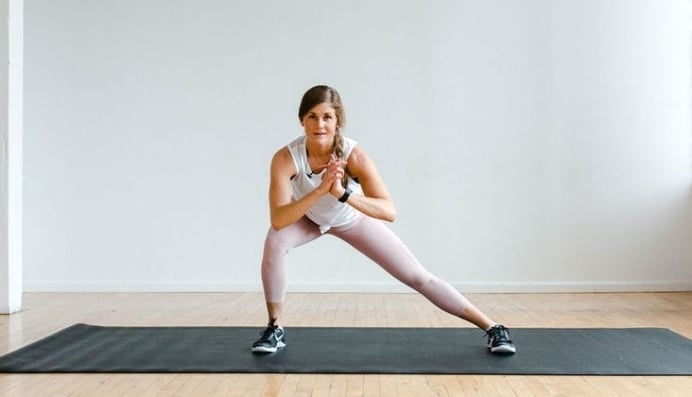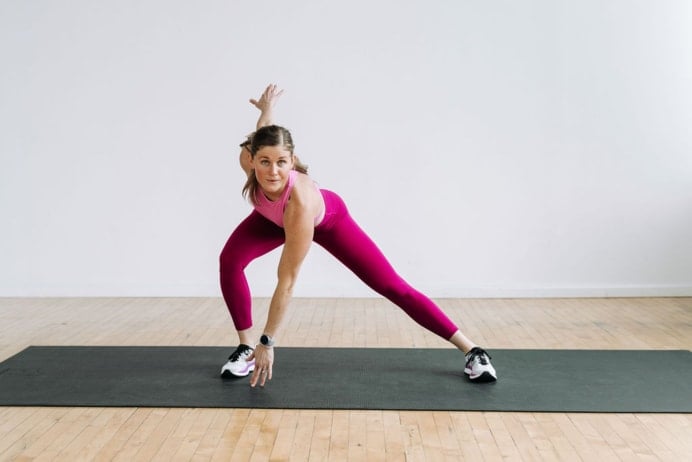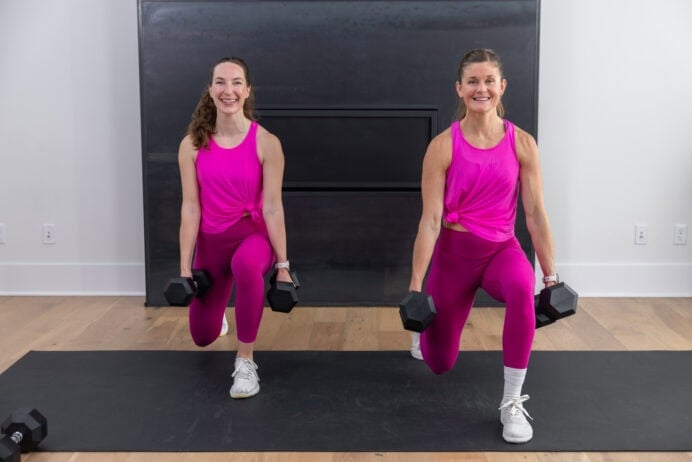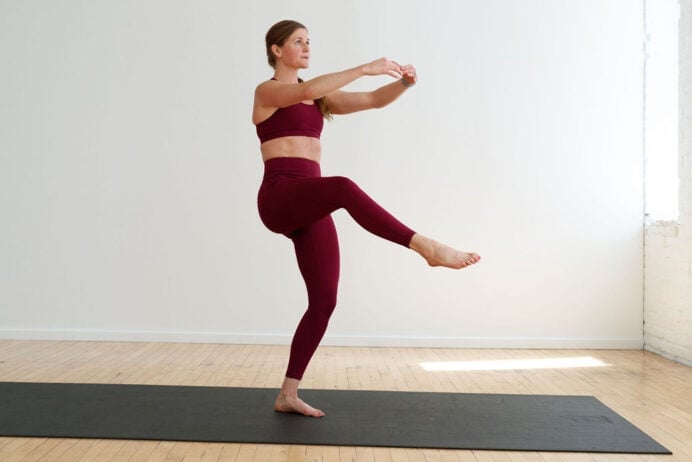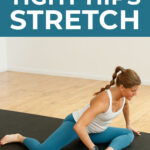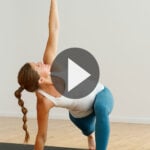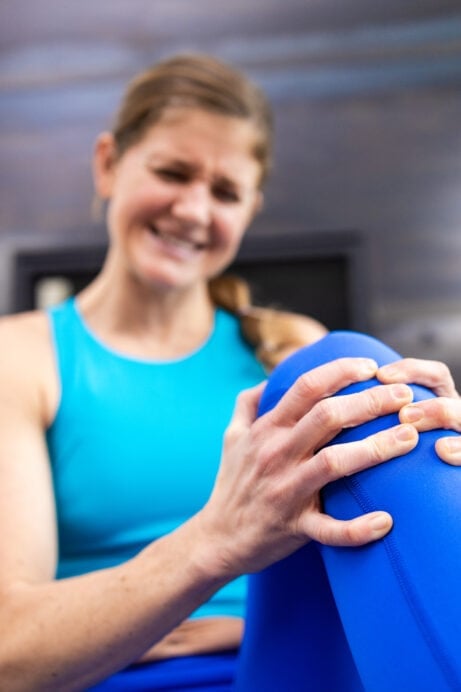
Best Hip Flexor Exercises (5 Stretches)
Loosen tight hips in just 10 minutes with this dynamic hip flexor stretching routine at home. These are 5 of the best hip flexor stretches to relieve hip pain and reduce lower back pain!
If you’re a runner, postpartum or work a desk job, odds are you have tight or weak hip flexors.
The hip flexors are the group of muscles near the top of your thighs and front of your hip, including the rectus femoris, iliacus, psoas, iliocapsularis and sartorius muscles. These muscles let you do everyday activities like walk, run, kick and bend to pick things up.
I’ve personally dealt with tight hip flexors for years, especially since having babies. Most people are surprised to find out that even though I film workout videos for a living, I spend most of my day sitting at a desk behind a computer. Prolonged sitting puts your hip flexors in a compressed position, causing them to shorten and tighten up.
Tight and stiff hip flexors can be uncomfortable on their own, but can also cause secondary issues. Because the hip flexors are closely connected to the core, pelvic floor, lower body (glutes, quads, hamstrings, adductors) and diaphragm, hip flexor issues can result in symptoms like lower back pain, knee pain and hip pain.
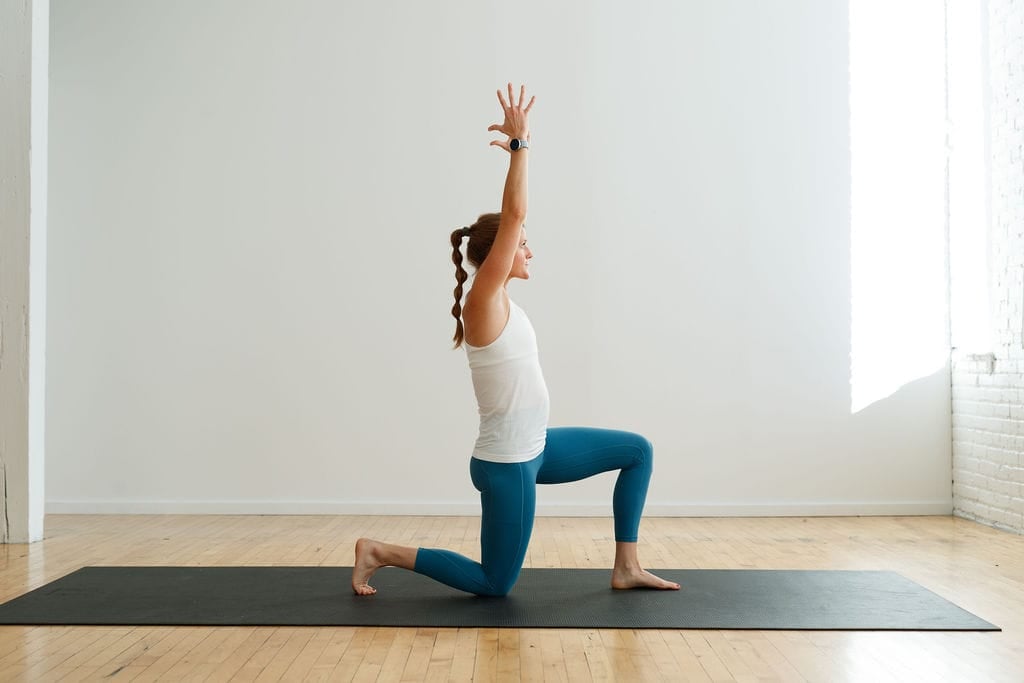
Tight hip flexors aren’t just limited to people who spend their days sitting. It’s also incredibly common for runners and bikers to have tight hip flexors due to the repeated motion of lifting their legs, and for postpartum women to develop tight hip flexors to compensate for weakened pelvic floor and core muscles during and after pregnancy.
If you struggle with painful hip flexors, I recommend adding in additional mobility and movement during your day (walking is a great way to keep hip flexors loose), as well as a mix of exercises that both strengthen the hip flexors and stretch the hip flexors.
Whether you have a sedentary or active lifestyle, these five hip flexor exercises will benefit both beginners and advanced athletes.
Workout Details
These gentle stretches are designed for all fitness levels to both lengthen and strengthen the hip flexor muscles – reducing pain, improving posture and preventing future injuries.
I like to do these stretches first thing in the morning before my work day starts. You also add them to a full-body stretch session or combine them with ankle mobility exercises as a warm-up for your leg day workout. I recommend adding this mobility routine to your training regimen 1-2 times a week.
Workout Equipment
You don’t need any special equipment for these, just your bodyweight and a yoga mat.
Workout Instructions
Follow along with the guided 10-Minute Hip Flexor Relief Video on YouTube, led by me — your certified personal trainer, Lindsey Bomgren.
Your Workout Looks Like This:
- 5 Stretching and Strengthening Exercises for Hip Flexors
- Timed Intervals (Perform Each Exercise for 45 Seconds, followed by a 15-second rest/transition between moves)
Perform Each Hip Exercise x2 (alternating sides during the second round)
Workout Outline

1. Half-Kneeling Hip Flexor Stretch
Targets: Hip flexors (especially the iliopsoas muscle group, which includes the psoas major and iliacus) and quadriceps (rectus femoris).

How to Do a Half-Kneeling Hip Flexor Stretch
- Start in a low lunge position with your right leg forward and left leg back. Both knees bent at 90 degrees. Drop your left knee to the mat for stability.
- Square your hips to the front by tucking your tailbone, performing an anterior pelvic tilt. Focus on keeping your back straight rather than leaning forward. Option to raise both arms directly overhead.
- To further intensify the stretch, you have the option to raise your left knee off the mat and find a low lunge position (squeezing your glutes). You should feel the stretch through the front of the hip of your back leg.
- With control, drop your knee to the mat, returning to the starting position.
Modification: If kneeling is uncomfortable for your knees, you can perform this stretch from a standing position.
2. Spiderman Hip Stretch
Targets: The hips, hip flexors (both hip flexion and external rotation), iliopsoas, rectus femoris and adductors (inner thigh muscles).
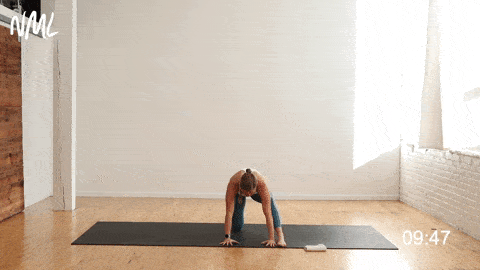
How to Do a Spiderman Lunge with Hip Opener
- Start in a high plank position, shoulders stacked over wrists and core engaged.
- Step your right foot outside your right hand, right foot planted firmly on the ground and right knee bent at 90 degrees.
- Drop your left knee to the ground. Square your hips to the front by slightly tucking your tailbone.
- Then gently rock your hips back, straightening your right leg and pushing your glutes back towards your left heel, finding a half-splits stretch.
3. 90/90 Hip Stretch
Targets: The glutes, piriformis, psoas, hip flexors, hip abductors and hip adductors.
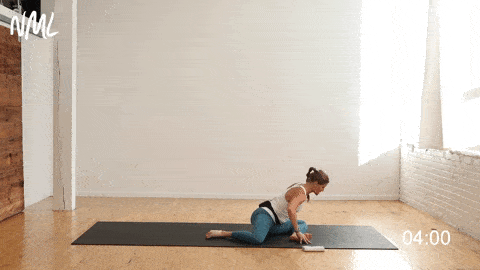
How to Do a 90/90 Hip Stretch
- Start in a seated position on the floor with both legs bent at 90-degree angles. Your right leg should be in front of you and your left thigh slightly angled behind your body.
- Square your chest over your front right thigh and sit up tall, creating length through your spine.
- Then, hinge at the hips to press your upper body over your front shin, deepening the stretch in your external rotators (glutes and piriformis) of your right hip. Press your back (left) knee into the mat to target the internal rotators.
- Keep your feet in place as you switch sides, rotating both knees and chest towards the left so your left shin is now in front of your body, right leg behind you.
- Repeat, hinging at the hips to press your chest over your left shin.
4. Side-Lying Pretzel Stretch
Targets: Quadricep muscles, outer glutes, hip flexors, low back and lumbar spine.
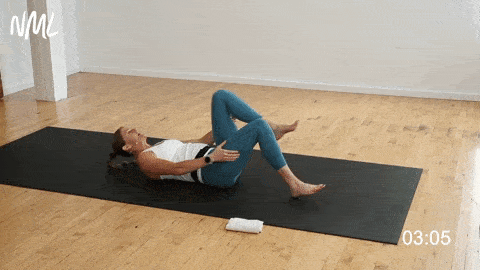
How to Do a Pretzel Stretch
- Start lying on your back, legs lifted with knees stacked over hips; knees bent at 90 degrees.
- Keep both shoulders pressed into the mat, then slowly roll towards your left side, dropping your right leg across your body, maintaining a 90-degree bend in your right knee. Range of motion will look different for everyone. Aim to drop your right knee closer to the mat with each exhale.
- Hold this position, then use your right hand to grasp your left foot, pulling your left foot towards your left glute to stretch through the front of your left leg (your left quad). Tight quads can contribute to limited hip mobility.
5. Supine Hip Flexor Stretch
Targets: Glutes, hips, hip flexors and low back.
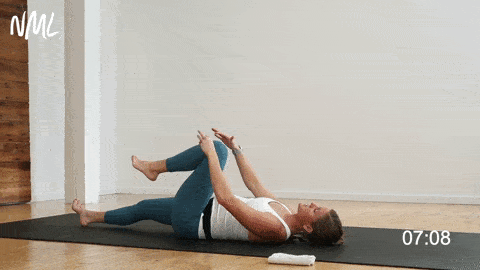
How to Do a Supine Hip Flexor Stretch
- Lie flat on your back, both legs long and extended on the mat.
- Pull your left knee toward your chest. Keep your opposite leg extended, right toes pointed. Both hips stay grounded on the mat.
- Slowly guide your left knee out towards your left armpit, feeling a gentle stretch through the left hip and groin.
- Then gently bring your left knee across your body toward your right shoulder, allowing internal rotation through the hip.
- Move slowly between the external rotation (knee to left armpit) and internal rotation (knee to right shoulder).
FAQs
Some of the best hip flexor strength exercises include standing marches, seated straight-leg raises, hanging leg raises, and dead bugs. These exercises can be done with just your bodyweight, or add a resistance band to increase the intensity.
These movements are effective because they isolate the hip flexors and emphasize controlled motion, which is especially important when your hip flexors are weak and larger muscle groups tend to take over (leading to muscle imbalances).
Lower back pain, hip discomfort or pinching, an anterior pelvic tilt (an exaggerated arch in the lower back), knee pain and glute inhibition (trouble activating the glutes) can all be symptoms of tight hip flexors.
Additionally, issues such as pelvic floor tension or dysfunction, sciatica-like nerve tension (due to psoas pressure on nearby nerves) and walking with a shortened stride can be connected to tight hip flexors.
There are a few reasons you might struggle with tight hip flexors. Some of the most common are: long periods of sitting, participating in sports/physical activities that largely rely on the hip flexor (e.g., running, dancing) or weak core muscles.
Your hip flexors tend to jump in and try to ‘take over’ the work of stabilizing your pelvis and core if your core muscles aren’t strong enough.
In addition to aiming to be more active throughout the day, I recommend adding hip flexor stretches and dedicated hip mobility exercises to your training routine 1-3 times a week.
Keep in mind that it’s important to actively keep your body from tensing up as you hold a stretch. Think about “releasing” the tension and stiffness in each muscle group as you perform stretching and mobility exercises.
More Workouts
Stretching WorkoutsPin This Hip Flexor Stretching Routine
